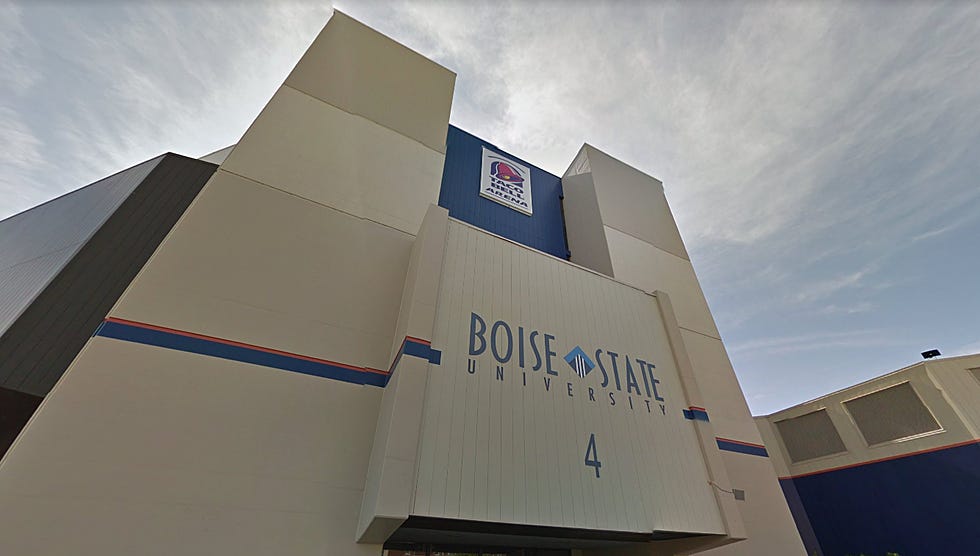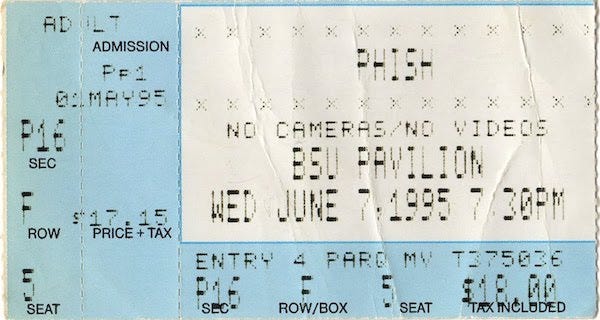
Three weeks after a sneak preview in Massachusetts, Phish unveiled the full release of Phish 95, its operating system for the next year and then some, on the other side of the country. In the remote environs of Idaho, Phish carried over five new songs debuted at the Voters for Choice benefit and added two more: Taste and Acoustic Army. Unless you had a fast tape hook-up or were lucky/nuts enough to travel thousands of miles between Phish shows, this show was a similarly bewildering avalanche of unfamiliar material.
But the new songs only tell half the story on this night. As the first “normal” show of the year — two sets, a properly-sized venue, no opening acts or political messaging — it’s our first honest chance to hear how the band has changed in the 5+ months since they closed out 1994 on a flying hot dog in Boston.
It’s not clear what the members of Phish were up to for the first third of 1995; this is the last year without a significant side project, and the recording of their next studio record is still a year away. It’s such a slow offseason that the official This Month in Phish History post lists a Mike photo shoot for his alumni magazine as a notable activity. But the one thing we do know they were doing was compiling A Live One, listening to hundreds of candidates for the record and condensing it down to the dozen tracks they’d release in late June.

This review process takes place at a time when the band would still listen back to their shows on a regular basis, as they (well, Trey, mostly) relentlessly fine-tuned setlists, songs, and improvisational approaches. But this was surely a deeper listening exercise than usual, with several quiet months to sort through tapes at home instead of on a tour bus, attempting to identify the moments from Fall 94 that best represented their strengths for a mainstream audience. It’s easy to imagine this deep self-analysis provoking some serious re-think of what the whole Phish project should be — or shouldn’t be.
So what did Phish want to sound like after this intense period of self-examination? There are some clues from interviews of the time, though it’s hard to take them entirely at face value. Here’s one from Burlington’s Vox magazine in early May:
I: How would you describe your music to other people?
MG: Actually, I've got something funny to say about that. Paul was on the phone with some company and the woman was saying, "What kind of music are they, anyway — hard rock or Elton John?"
I: Those were the only choices?
MG: Yeah. He said Elton John.
I: What would you have said?
MG: Hard rock.
I: And if you had other choices?
JF: That's always the hardest question.
TA: I know what I'd like to think.
I: What's that?
TA: I'd like to think we were Sun Ra meets the Velvet Underground in a seedy New York bar. But it's not true.
JF: That's what we're shooting for, though. No — Sun Ra meets Velvet Underground at a bluegrass festival. In the middle of Appalachia.
TA: In the middle of a scene from Deliverance.
I: That's good. So if I were to ask you if you had a new musical direction, that would be it?
JF: That would be it.
MG: Or Iggy Pop meets Jerry Garcia and kicks his ass.
Now “Sun Ra meets Velvet Underground at a bluegrass festival in the middle of Appalachia” sounds pretty fucking good to me, even if it’s more of an aspiration than an accurate description of Phish at this moment. The VU ingredient in that recipe squares with what I wrote last month regarding the new songs and their emphasis on texture — the Velvets are certainly not known for their virtuosity, but were masters of carving out mood from noise. (Similarly, Mike’s deadpan “hard rock” would also prove prescient by December 95, while at the same time, Strange Design is pretty Elton John.)
But the other two pieces of the puzzle are equally important. Citing Sun Ra and bluegrass festivals speaks to a less directly sonic emphasis that is really about to take off this year: collectivism. At this point, Phish had largely abandoned playing straight jazz, and the bluegrass “mini-sets” would be left behind in 1994. But both genres are forms based around group interplay, which has long been the goal Phish strives for. Visiting the band at their rehearsal space in May 1995, Parke Puterbaugh found them hard at work on the “hey hole” exercise:
The group is working on a song called “Taste,” a radically retooled version of which appears on Billy Breathes. In rehearsal, the song is a complicated piece of music in which the band members play asymmetrical parts in different meters. They know what they’re aiming for, but so far, they can’t quite nail it.
“Get the hell out of my hey hole,” Anastasio barks at Fishman. What’s this? A band spat? Bad vibes in Ben & Jerry country? And what the hell is a hey hole?
According to Anastasio, one of Phish’s self-devised communication exercises is something called Including Your Own Hey. The idea is that to improve the band’s collective improvisation, the members must learn to listen to one another. They do this by conjuring riffs and patterns from thin air, varying and embellishing them until they’re locked in and individually announcing their arrival with the word hey. When they’ve each “included their own hey,” it’s onto another round. A variation on the process is Get Out of My Hey Hole, in which the cardinal rule is that one band member’s note cannot sustain over anyone else’s.
“Mimicry is the lowest, most basic level of communication,” explains Anastasio. “These are anti-mimicry exercises: listening to each other, hearing each other, staying out of each other’s way.” The band goes at it for hours on end. “This is what we spend our time doing,” Anastasio says. “This is our job.” After a while, the tangent is abandoned, but it serves to demonstrate Phish’s internal creativity, which is greater than their thirst for external acclaim.
The “Hey Hole” exercise is far from new for the Phish practice room, but intriguingly Puterbaugh describes its usage here in the context of developing a new song, not just generally sharpening their improvisational ears. So while more democratic jams will quickly become a storyline over this tour and year — Trey’s mini percussion kit debuted at this show, though I don’t hear it used at any point — there also seems to be a push for a more equal distribution in the songs themselves.

This objective reveals itself through the first night, in songs both old and new. Four of the new batch played on this night — Taste, Spock’s Brain, Acoustic Army and Theme From The Bottom — are full-band compositions. The first set has three songs with lead vocals by Mike, including a moderate 89-show bustout of Weigh, and a new one so explicitly written for Page to sing that Fish introduced it on 5/16 as “Ahh, Page Sing.” Acoustic Army might be the most literal example of leveling out the Phish playing field, as the instrumental puts all four members on the same exact instrument, a trick they’d repeat in the fall with its sister song Keyboard Army/Cavalry.
As for how the offseason has affected the band’s approach to improvising, that discussion will have to come later. There are some brief, thrilling sparks of dissonance (Theme, Stash) and diminuendo (Slave, Possum, Hood) in the show, but with no track lasting beyond 15 minutes and nary a true segue, they’re still stretching their jam muscles in traditional tour opener fashion. Speaking of which, the new songs also still need to find their proper, comfortable place in the show; the band’s enthusiasm leads them to line up 5 rookies in the first six songs of the second set, surely baffling the unsuspecting Idahoans in attendance.
Wait, was I talking about 1995 or 2019? It’s an oft-repeated pattern in Phish history: a sudden influx of new material > some wobbly shows > fan complaints > a seemingly sudden breakthrough to improvisational brilliance > all is forgiven. The jams always draw fresh energy from the presence of new songs, even if they don’t always take place in the new songs themselves. For this particular iteration of the cycle, it’s the collaborative nature of those new additions to the catalog that seed the rest of the year’s metamorphosis.



Thanks for the memories. There were some Idahoans in attendance for certain, but I recall the lot and local campgrounds filled with folks from all over - VA, VT, CO, WA, NY and CA (where my crew traveled from). I was living in Tahoe at the time and when Dead tour wound up in Shoreline the weekend before this show, we got back on the bus and did the first leg of Phish tour, including Boise (an 8 hour jaunt from Tahoe City). I took two Phish noobs, and they weren’t sure if they just saw a hard rock show or a Broadway theatrical. Oh to be 25 again!
Excellent read! I loved the parallels between’95 and the present you present in the conclusion. Thanks for sharing.